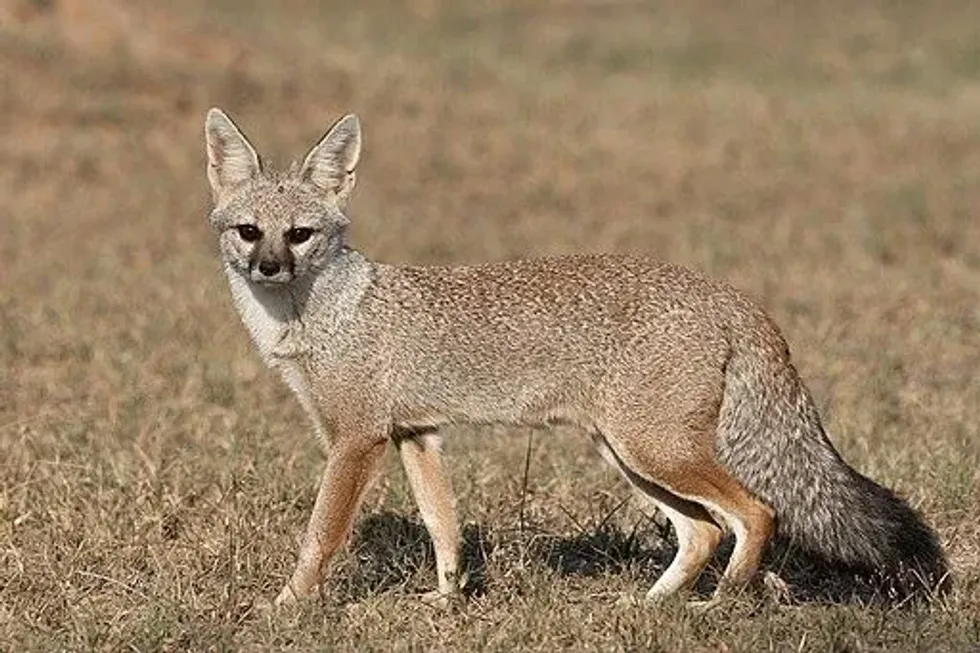The Bengal fox (Vulpes bengalensis), also known as the Indian fox, is a beautiful animal that mainly lives in and around the Indian subcontinent. In India, it can be found from the Himalayan foothills to the tip of the Indian peninsula.
They also inhabit some surrounding countries like Nepal, Pakistan, and Bangladesh. The primary habitat of these foxes is foothills, arid deserts, semi-desert areas, and grasslands, However, they are known to avoid any long grassland and steep terrain.
These foxes have a grayish brown to grayish-white body with a tail that makes up more than half their body length. This fox with an elongated muzzle can seem pretty adorable due to its tame nature. They are also not at all afraid of human contact which makes them vulnerable to hunting.
Read on to know more about the Bengal foxes, and if you like this article, then also check out Bismarck flying fox and goblin bat.
Bengal Fox Interesting Facts
What type of animal is a Bengal fox?
The Bengal fox (Vulpes bengalensis), otherwise known as the Indian fox, is a species of fox native to the Indian subcontinent.
What class of animal does a Bengal fox belong to?
The Bengal fox belongs to the genus Vulpes and class Mammalia of animals.
How many Bengal foxes are there in the world?
The population of the Bengal fox is widespread but not common in its habitat range. The population depends a lot on the availability of food in their geographical range. Research on this fox species has been hard to do which is why the exact population of Bengal foxes is not known.
Where does a Bengal fox live?
Bengal foxes are primarily found in India. They can also be seen in the surrounding countries of Pakistan, Bangladesh, and Nepal. In India, they are mainly seen living in the range from the tip of the Indian peninsula to the Himalayan foothills.
What is a Bengal fox's habitat?
The Bengal fox habitat includes thorny scrubs, arid, semi-desert, agricultural fields, and grassland habitats, like any open grassland or short grassland. However, they have been seen to avoid any long grassland and steep terrain. They make their burrows under the ground and these burrows have many openings, all leading to one center.
Who do Bengal foxes live with?
These are primarily solitary animals. However, foxes in pairs or in aggregations can be seen in their breeding area and during the breeding season. Also, a group of mothers can be seen living in the same den after giving birth. Otherwise, they are known to forage alone.
How long does a Bengal fox live?
Due to a lack of research, the lifespan of an Indian fox lives is not known. True foxes like the Arctic fox are known to live for 10-12 years. We can assume that the lifespan of the Bengal fox falls somewhere in this range too.
How do they reproduce?
The breeding season of Bengal foxes occurs from months of December to January. The arrival of the breeding season can be seen by the digging up of old burrows or the creation of a new burrow.
Most foxes use their old breeding burrows repeatedly for a long time for the purpose of pup rearing. They are also monogamous in nature. Not much is known about their courtship behavior.
The gestation period for a female Bengal fox lasts for about 50-53 days. After that, a female Bengal fox gives birth to two to six young cubs.
Both the males and females do the parental work after the pups are born as both parents take turns guarding the cubs and foraging for food. The parents take care of the pups for at least four to five months after the pups are born.
What is their conservation status?
The conservation status of the Indian fox, according to the International Union for Conservation of Nature, is listed as Least Concern. Indian Wildlife Conservation has included the Bengal fox in Schedule II for the wildlife protection of this animal and has made hunting this species illegal.
Bengal Fox Fun Facts
What do Bengal foxes look like?
Vulpes bengalensis (Bengal fox) is a medium-sized fox. They are grayish white-colored which grows whiter still on the belly. They have black-colored fur on a little area above their elongated muzzles. The long, pointed ears are usually dark brown-colored with a black-colored margin.
These ears are quite large when compared to their body size. These foxes have a beautiful long bushy tail which takes up about 60% of their body length. This tail has a distinguishing black tip to it.
How cute are they?
The Indian fox with an elongated muzzle, beautiful gray body color, long pointed ears, and long bushy tail, has a magnificent look. They are also calm and tame by nature and hardly become aggressive. These traits surely add to their charm.
How do they communicate?
Bengal foxes communicate vocally and by scent. Scent marking is done to mark its territory and for hunting purposes. They usually make sounds like whining, growling, growl-barking, or whimpering. To establish a territory, they are also known to make a chattering cry sound. Their sounds can be heard the most during the breeding season, from dusk to dawn.
How big is a Bengal fox?
The Bengal fox size is about 18-24 in (45.7-61 cm) in length. The Bengal fox is the same size as the bat-eared fox which is about 17.7-25.9 in (45-66 cm) in length.
How fast can a Bengal fox move?
The exact speed at which the Indian fox moves is not known, but they are known to be quick and active, mainly at night.
How much does a Bengal fox weigh?
The medium-sized Bengal fox is known to weigh about 5-9.2 lb (2.3-4.2 kg).
What are the male and female names of the species?
Like any other fox species, the male is known as reynard, and the female is known as a vixen.
What would you call a baby Bengal fox?
Bengal fox babies are called kits or pups.
What do they eat?
The Bengal fox diet is omnivorous and opportunistic. They eat small rodents, reptiles, insects, different kinds of fruits, birds like the Indian myna, and their eggs.
Are they dangerous?
The Bengal fox is not dangerous or aggressive in nature, but it might be a different story if they feel threatened. They are so tame by nature and unaffected by human populations around them that they often fall prey to hunting.
Would they make a good pet?
These are wild animals, and taking them out of their habitat range would only harm the animals. It is better to leave them in their specific wildlife range.
Did you know…
Bengal fox adaptations include only its ears. They are known to be long-shaped to adapt to their hot and arid habitat where they need to keep the balance of the temperature of their body.
How are Bengal foxes different from other fox species?
What makes the Bengal fox different from other fox species, like the red fox, is its long and bushy tail. The most distinguishing factor is this tail takes up about 60% of the body length of the Bengal fox.
Why is the Bengal fox population decreasing?
The population of the Indian fox is decreasing because they fall prey to hunting, diseases, and habitat loss. It is not known how many species of foxes there are in the world, but in the Indian subcontinent, only two species of foxes have been seen, the Bengal fox and the red fox.
The population of both species is widely distributed, but neither are increasing. The population trend of red foxes is stable, but the population trend of Bengal foxes is decreasing.
Here at Kidadl, we have carefully created lots of interesting family-friendly animal facts for everyone to discover! Learn more about some other mammals from our swift fox facts and flying squirrel facts pages.
You can even occupy yourself at home by coloring in one of our free printable Bengal fox coloring pages.










